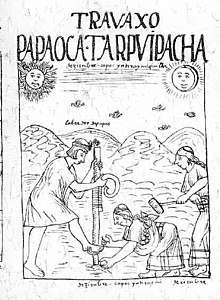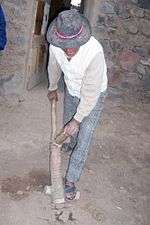Foot plough
The foot plough is a type of plough used like a spade with the foot in order to cultivate the ground.

New Zealand
Before the widespread use of metal farm tools from Europe, the Māori people used the kō, a version of the foot plough made entirely of wood.[1][2]
Scotland
Prevalent in northwest Scotland, the Scottish Gaelic language contains many terms for the various varieties, e.g. cas-dhìreach "straight foot" for the straighter variety and on, but cas-chrom "bent foot" is the most common variety and refers to the crooked spade. Although no longer as common as they once were, they are still used in some places, especially the Outer Hebrides.
It is an implement of tillage peculiar to the Highlands, used for turning the ground where an ordinary plough cannot work on account of the rough, stony, uneven ground. It is of great antiquity and is described as follows by Armstrong:
It is inexpeditious in comparison with the plough, eight men being necessary to dig as much with it in one day, as a horse would plough in the same time. It is chiefly used for tillage, and consists of a crooked piece of wood, the lower end somewhat thick, about two-and-a-half feet in length, pretty straight, and armed at the end with iron made thin and square to cut the earth. The upper end of this instrument is called the ‘shaft’, and the lower the ‘head’. The shaft above the crook is pretty straight, being six feet long, and tapering towards the end which is slender. Just below the crook or angle, there must be a hole wherein a straight peg must be fixed, for the workman’s right foot in order to push the instrument into the earth; while in the mean time, standing on his left foot, and holding the shaft firmly with both hands, when he has in this manner driven the head into the earth, with one bend of his body he raises the clod by the iron-headed part of the instrument, making use of the ‘heel’ or hind part of the head as a fulcrum. In so doing, he turns it over, always to the left hand and then proceeds to push for another clod in the same form. To see six or eight men all at work with this instrument, standing on one leg and pushing with the other, would be a curious sight to a stranger. With all of its disadvantages, the cas-chrom is, of all the instruments, fittest for turning up the ground in the country, for among so many rocks, a plough can do little or nothing, and where there are no rocks, the ground is generally so marshy that cattle are not able to pass over it without sinking in deeply.
In the Western Isles, with a foot plough though, perhaps one man can do the work of four men with an ordinary spade, so while it is disadvantaged compared to a horse-plough, it is also well suited to the country.
Andes

The most advanced agricultural tool known in the New World before the coming of the Europeans was the Andean footplough, also known as the Chakitaqlla or simply taklla. It evolved from the digging stick and combined three advantages: metal point, curved handle, and footrest.[3] No other indigenous tool utilized the pressure of the foot in digging up the sod which made it different from all farming implements known elsewhere in the Americas in pre-Columbian times.[4] Although Chakitaqlla is a relatively simple instrument, it has persisted long after more sophisticated technology was introduced into the Central Andes, and its enduring presence demonstrates that more advanced innovations do not necessarily displace primitive forms that under certain conditions may be more efficient.
Historic distribution and the current diversity of forms point to the mountainous region of Southern Peru as the likely place of origin of the chakitaqlla.[3] With the expansion of the Inca Empire, the taklla was carried north to Ecuador and south to Bolivia where early colonial writings confirmed its presence.[5] It probably never occurred in Southern Chile, either before or after the conquest by the Spaniards.[6]
It is probable, nevertheless, that agricultural peoples living on the Peruvian coast long before the Incas contributed to the idea of the taklla. Copper-shod digging sticks known by the Mochica culture (ca.500 A.D.) may have been a forerunner of the taklla.[7] Pottery representations and remains of proto-taklla tools from the Chimu culture (1300 A.D) on the coast verifies its development by at least that time.[8] However, the friable soils of the coastal desert were easily turned without the taklla, and the incentive to develop such a tool probably came from the adjacent Highlands.
Men wielded the plow, called a chakitaqlla. It was made of a pole about 2 m long with a pointed end of wood or bronze, a handle or curvature at the top, and a foot rest lashed near the bottom.[9]
The Inca Emperor and accompanying provincial lords used foot ploughs in the "opening of the earth" ceremony at the beginning of the agricultural cycle.[10] Incan agriculture used the chaki taklla or taklla,[11] a type of foot plough.
Chakitaqllas are still used by peasants farmers of native heritage in some parts of the Peruvian and Bolivian Andes. Modern chakitaqllas have a steel point.
See also
References
- Story: Farm mechanisation, Page 2 – Machines powered by humans and animals, Te Ara: The Encyclopedia of New Zealand (retrieved 16 November 2017)
- A KUMARA PLANTING SCENE OF THE PAST: DIGGERS USING THE KO PREPARING THE GROUND FOR THE KUMARA SEED TUBERS.
- Wynne Gade, Daniel; Rios, Roberto. "Chaquitaclla, the native footplough and its persistence in central andean agriculture" (PDF). Museum voor de Oudere Technieken.
- (Donkin 1970, 514)
- (Jimenez de la Espada 1965, II, 227; Vázquez de Espinosa 1942, 660)
- Tschudi's (1849, 14)
- (Bushnell 1957, 83)
- (Horkheimer 1960)
- D'Altroy, Terence N. (2014-05-27). The Incas. John Wiley & Sons. ISBN 9781444331158.
- Inca vessel in the form of a digging stick, Peru, 15th-16th century, exhibit at the British Museum referencing C. McEwan, Ancient American Art in Detail, London, The British Museum Press, 2009, (retrieved 16 February 2012)
- Teofilo Laime Ajacopa, Diccionario Bilingüe Iskay simipi yuyayk'ancha, La Paz, 2007 (Quechua-Spanish dictionary)
This article incorporates text from "Dwelly's [Scottish] Gaelic Dictionary" (1911).